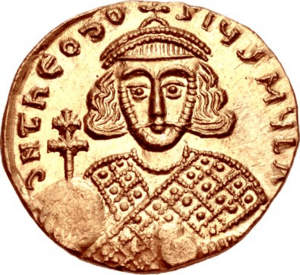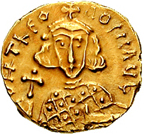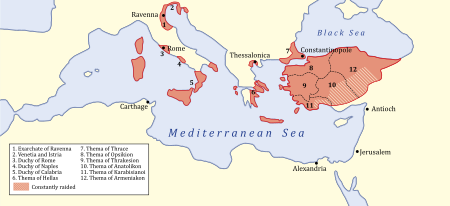Theodosius III facts for kids
Quick facts for kids Theodosius III |
|
|---|---|
| Emperor of the Romans | |

Solidus of Theodosius III. The inscription reads d n theodosius mul a.
|
|
| Byzantine emperor | |
| Reign | c. May 715 – 25 March 717 |
| Predecessor | Anastasius II |
| Successor | Leo III |
| Died | after 717, possibly on 24 July 754 |
| Issue | Theodosius |
Theodosius III (Greek: Θεοδόσιος, romanized: Theodósios) was a Byzantine emperor who ruled from about May 715 to March 25, 717. Before becoming emperor, he worked as a tax collector in a town called Adramyttium.
In 715, the Byzantine navy and soldiers from a region called the Opsician Theme rebelled against Emperor Anastasius II. They chose Theodosius to be their new emperor, even though he didn't want the job. Theodosius led his troops to Chrysopolis and then to Constantinople, the capital city. They took control of Constantinople in November 715.
Emperor Anastasius II gave up his throne a few months later. He agreed to live in a monastery for his safety. Many other regions of the Byzantine Empire did not think Theodosius was the rightful emperor. They saw him as a "puppet" controlled by the Opsician soldiers.
Two powerful generals, Leo the Isaurian and Artabasdos, did not accept Theodosius as emperor. Leo declared himself emperor in the summer of 716. He made an alliance with the Umayyad Caliphate, a large Islamic empire. Theodosius asked the Bulgarians for help. He made a deal with their leader, Khan Tervel. This deal set a clear border in Thrace and gave the Zagoria region to the Bulgarians. Theodosius also agreed to pay them tribute.
Leo then marched his army towards Constantinople. He captured the city of Nicomedia and took many officials, including Theodosius's son, also named Theodosius. With his son held captive, Theodosius listened to the advice of important leaders. He decided to step down as emperor and recognize Leo as the new ruler. Leo entered Constantinople and took power on March 25, 717. Theodosius and his son were allowed to retire to a monastery. We are not sure when Theodosius died, but it might have been on July 24, 754.
Contents
A Time of Trouble: The Twenty Years' Anarchy
The Empire's Challenges
The Byzantine Empire faced many dangers before Theodosius became emperor. After a big battle in 674-678, the Arabs and Byzantines had a time of peace. But Emperor Justinian II started fighting again. This led to many Arab victories. The Byzantines lost control of areas like Armenia.
Each year, generals from the Umayyad Caliphate would raid Byzantine lands. They captured forts and towns. After 712, the Byzantine defenses became weaker. Arab raids went deeper into Byzantine Asia Minor. Many border areas became empty because people were killed, enslaved, or forced to leave. This encouraged the Arabs to plan a second major attack on Constantinople.
The Slavs and Bulgars also threatened the northern part of the empire. In 712, the Bulgarians, led by Khan Tervel, reached the walls of Constantinople. They robbed the countryside around the capital.
The "Twenty Years' Anarchy"
Theodosius became emperor during a very unstable time called the "Twenty Years' Anarchy." This period was full of struggles between emperors and powerful nobles. Emperors changed very quickly. Many nobles were from Asia Minor. They often just wanted to stop emperors from becoming too strong.
This period of chaos began in 695 when Emperor Justinian II was overthrown. This ended a family's rule that had lasted eighty years. During the Twenty Years' Anarchy, seven different emperors took the throne. Only two of them, Tiberius III and Anastasius II, were considered good leaders. The chaos finally ended when Leo III overthrew Theodosius. Leo's family then ruled for 85 years.
How Theodosius Became Emperor
The Byzantine Empire knew that the Arabs were preparing for a huge attack. Emperor Anastasius II started getting ready to defend the empire. He sent a spy to the Arabs and made Constantinople's defenses stronger. He also improved the Byzantine navy.
In early 715, Anastasius II ordered the navy to gather. But the soldiers from the Opsician Theme rebelled. They killed their commander and sailed to Adramyttium. There, they declared Theodosius, a tax collector, as their new emperor. Some historians believe he was chosen because he had a name that sounded like an emperor's. He was also seen as a quiet person who could be easily controlled.
Theodosius supposedly did not want to be emperor. One old story says that when the soldiers found him, he ran and hid in the hills. But they found him and forced him to accept the title of emperor.
The Opsician soldiers made Theodosius III emperor around May 715. Emperor Anastasius tried to stop the rebellion. But Theodosius led his fleet to Chrysopolis, which was across the water from Constantinople. From there, he attacked Constantinople for six months. Finally, his supporters inside the city opened the gates. He took control of the city in November 715. Anastasius stayed in another city for a few months. He then agreed to give up his throne and live in a monastery.
Theodosius's Short Rule

One of Theodosius's first actions as emperor was to bring back a religious image that a previous emperor had removed. This action earned him praise. However, many people saw Theodosius as a weak emperor. They believed he was just a "puppet" of the Opsician soldiers.
Because of this, two important generals, Leo the Isaurian and Artabasdos, did not accept Theodosius as the true emperor. Leo declared himself emperor in the summer of 716. He also sought help from the Arabs. The Arabs saw this disagreement as a chance to weaken the Byzantine Empire and capture Constantinople.
Theodosius made a treaty with the Bulgarian leader Khan Tervel. He likely did this to get their support against the coming Arab attack. The treaty set the border between the Byzantine and Bulgarian empires. It gave the Zagoria region to the Bulgarians. It also said that the Byzantines would pay tribute to the Bulgarians and return people who had run away.
Around this time, the Arab army began moving into Byzantine lands. They attacked a city called Amorium. Leo then started marching his troops toward Constantinople. He first captured Nicomedia. There, he found and captured Theodosius's son, also named Theodosius.
With his son held captive, Theodosius decided to step down. He took the advice of important leaders, including the Patriarch and the Byzantine Senate. He agreed to recognize Leo as the new emperor. Many powerful people in Constantinople supported Leo. They believed Theodosius was not strong enough to handle the Arab threat.
Leo entered Constantinople and took power on March 25, 717. He allowed Theodosius and his son to retire to a monastery and become monks. After this, Theodosius might have become a bishop in a city called Ephesus. If so, he might have died on July 24, 754. Either he or his son is buried in a church in Ephesus. We don't know much about Theodosius III's time as emperor.
Images for kids
See also
 In Spanish: Teodosio III para niños
In Spanish: Teodosio III para niños



